Blog
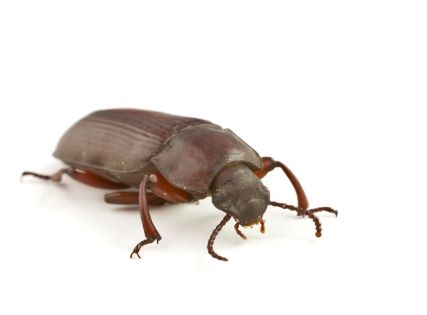
9 Tiny House Bugs – How to Identify & Get Rid Of These Little Invaders!
Are you tired of creepy bugs crawling in your house? Do you not know how to get rid of them?
Tiny house bugs are way more common than you think. They can be found in the cleanest of homes. Yet, there is no doubt that anyone can easily be “bugged” by this issue.
These tiny creepy-crawlers infestations can turn into a big concern if not taken care of at the right time. Here we will provide detailed information on how homeowners can identify and get rid of these uninvited guests from their homes.
Identifying Different Tiny House Bugs And Getting Them Out
Cockroaches (Blattella Gernancia)
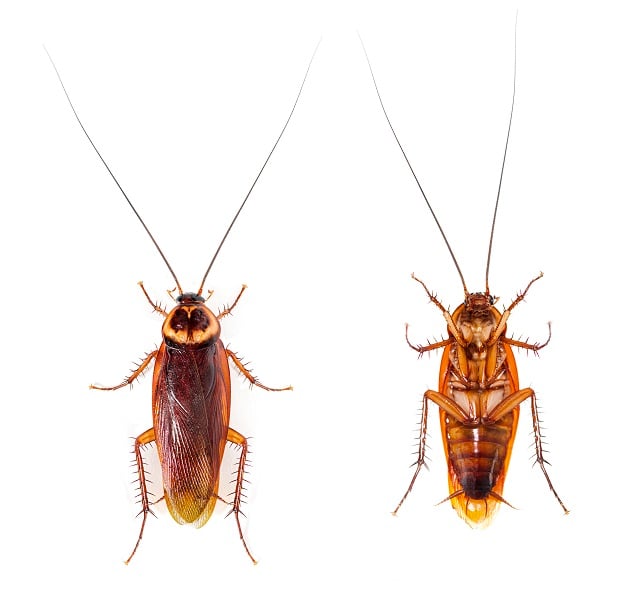
Cockroaches are very common tiny brown house bugs with long antennae, oval, slender bodies, and six legs. The average length of domestic roaches is 15 mm. The bigger roaches, called Periplaneta americana, have wings and can grow as big as 75mm.
These bugs are typically found in furniture, cabinets, kitchens and other dark places. They also like to nest near food sources, under stoves, fridges and moist areas like crawl spaces. Cockroaches are likely to come out when the lights are off and swiftly flee the lights.
Cockroach infiltrations happen mostly during shifting from one place to another when the property is left vacant for a number of days. They can even enter your home in used pieces of furniture, shopping bags, and pipes or enter your home through vents and drains.
Cockroaches love wet, warm, and dark environments. Their infestation must be eliminated because they can cause serious illnesses and diseases by contamination of food, water, and utensils.
How to get rid of cockroaches
- Glue traps to identify the areas of infestation.
- Set up bait stations.
- Seal all the entry points.
- Liquid concentrate to the rescue.
Carpet Beetles (Anthrenus verbasci)

Carpet beetles are also a very common species of household bugs. They are oval in shape and can grow up to 1.7 – 3.5mm. They have a dark erratic brown and yellowish color. They even have wings and can come into your house by flying.
Carpet beetles are harmless most of the time, however, their larvae can cause big problems. A single carpet beetle is capable of laying up to 90 eggs in its 4 to 8-week-long lifespan.
The fuzzy carpet beetle larvae feed on materials like wood and fabric. They can leave small holes in your furnishing by devouring your clothes, rugs, and carpets.
To identify these bugs, look for tiny yellowish-white bugs flying around lighting or crawling on the walls of your home. These tiny beetles also shed skin that can be recognized to identify the infestation.
How to get rid of Carpet Beetles
- Clean your rugs and other furnishings regularly and thoroughly.
- Do thorough vacuuming of the rugs.
- Get your furnishings professionally dry-cleaned often.
Spiders (Araneae)
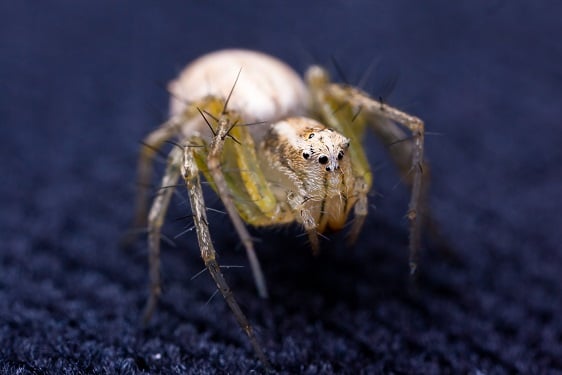
Everyone is aware of the notorious eight-legged monster beast bugs called spiders. They are also the most hated bugs in the world (at least that’s what we think).
They have eight spindly legs, a spherical body, and no antenna, which makes them easily recognizable (and scary of course). They can grow up to 20mm in length.
Some of the spiders can even have furry bodies, which sounds cute, but it really isn’t. Since spiders come in deadly variants, it is crucial to identify them. The black widow and the brown recluse spiders are two very dangerous spider species.
The brown recluse can be recognized by the violin-shaped marks on the front of its body. Black widow spiders can be identified by red patterns on black and glossy bodies.
The majority of small black spiders, nevertheless, are not thought of as bothersome creatures. Common spiders are quite useful because they eat flies that could harm your plants.
How to get rid of spiders
- Set up spider traps.
- Remove webs from all surfaces.
- Use peppermint oil and vinegar to keep the spiders away.
- Install screenings.
- Use insecticide.
Houseflies (Musca domestica)
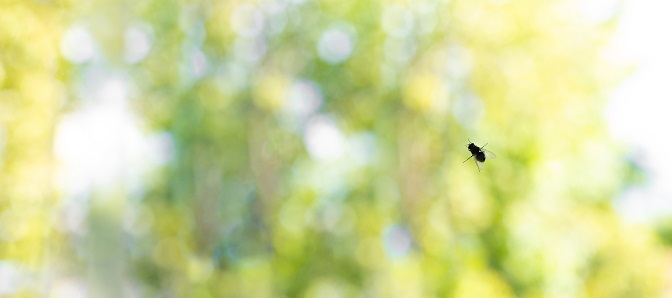
Houseflies, similar to fruit flies, are the most common flying bugs and can be found in almost every house. They can be as long as 4 mm to 7.5 mm in length and have a dark gray body, transparent wings, six legs, and huge compound eyes.
House flies don’t bite, but they can spread diseases by eating trash, pet food, and human waste and then contaminating your food by sitting and flying.
To stop them from spreading bacteria, you should destroy any of these tiny black flies you find inside your home. Clean up after your waste, shut the trash bins, and clean out any nasty objects in your house to stop house fly infestation.
You must get rid of the larvae to get rid of the flies. Houseflies can be identified by their small, dark gray body, huge round eyes, and propensity to buzz or flutter erratically around windows or light sources.
How to get rid of Houseflies
- Use Herbs and flowers.
- A mixture of vinegar and dish soap can help you entrap flies.
- Get a venus flytrap.
- Natural trap bait.
Weevils (Curculionoidea)
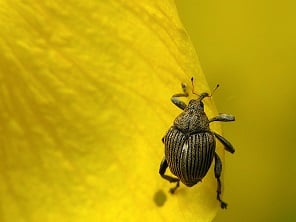
Weevils are thin common house tiny black bugs that can readily infest food in your pantry that aren’t sealed. Weevils are tiny, black beetles that have a long, unique snout and a body that resembles a pear.
These little black house bugs can grow to a length of 6mm. Even though they are nonvenomous, they can still contaminate food and water.
You can find these bugs hanging around your house, creeping on walls and window sills. You can generally just vacuum away these bugs if they become too bothersome.
But if you find a bunch of thin black bugs in your house, you need to clean your kitchen thoroughly and look for black bugs in all unsealed food products like cereals. Also, airtight containers may be a good option to save substantial food items.
Weevils are recognized by their glossy, oval, black body, large snout, and long antennae.
How to get rid of Weevils
- Wipe kitchen shelves with soapy and hot water.
- Use the disinfectant spray and wipe the surface with vinegar.
- Clean your kitchen thoroughly and do it often.
- Throw unsealed food away.
Centipedes
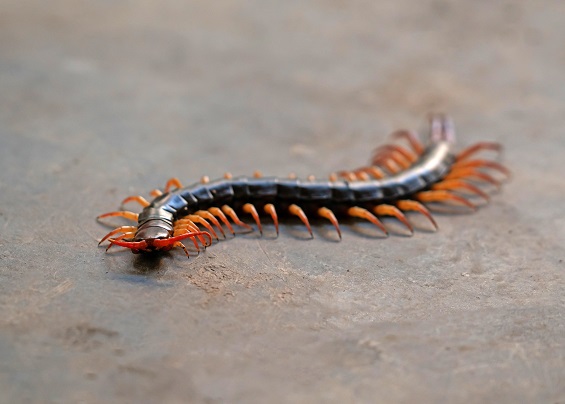
Anyone who has ever seen a centipede knows it is the creepiest thing to crawl our planet. It is identifiable by the number of legs it has and let us tell you, it’s A LOT. They also have two long antennae and two tails.
Centipede rarely bites, however, if they do, the pain can range anywhere from hardly perceptible to excruciating.
The length of a centipede can range from 10mm to 30 cm. Centipedes are usually found in isolated, dark places and they mostly emerge when it’s dark.
In residencies with mixture issues, centipedes are typical. They might be discovered in moist basements, bathrooms, or under sinks.
These lengthy, multi-legged bugs are less of an infestation and more of a terrifying insect to humans.
They are identified by the multiple pairs of legs that run the length of the centipede. They have slender bodies and can be recognized in an instant. Some centipedes can even have up to 117 pairs of legs.
How to get rid of centipedes
- Use an exterminator to kill them.
- Get rid of it by killing it using an object.
- Vacuum it and dispose of it at a suitable location.
Stink bugs (Halyomorpha halys)
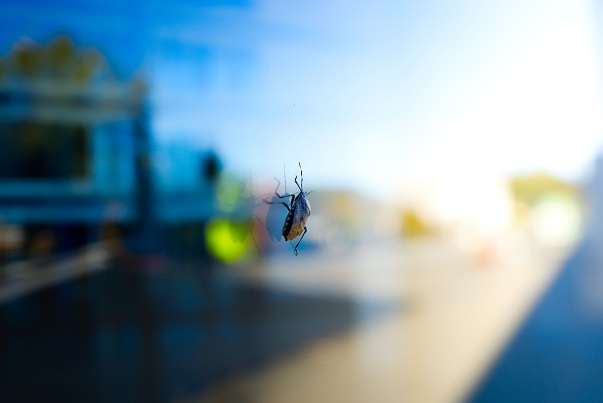
Brown insects have flat shield-shaped bodies. Stink bugs have two straight antennae and a brown body with brown mottling band designs on their front wings.
This little brown insect can be as long as 1.7 cm in length and 1.5 cm in width. Additionally, they give us a distinctively bad smell, especially when crushed.
These shield-shaped insects are generally safe for people to handle. The bugs overwinter in the attic and crawl the house after entering. They can enter homes through openings in the window or doors during fall.
In the spring, their foul stench becomes the most overt, causing the bugs to be more active than ever altogether.
The stink bugs have six legs, two dark antennae with white markings, and a unique marble-like patterning on their bodies. But the shield-shaped body is what makes the stink bug so distinctively different.
How to get rid of Stink bugs
- Seal off all the possible entry points on windows and doors.
- Reduces moisture-containing sites.
- Eliminate all sources of food the bug might be feeding on.
- Use essential oils to scare away insects.
Silverfish (Lepisma saccharina)
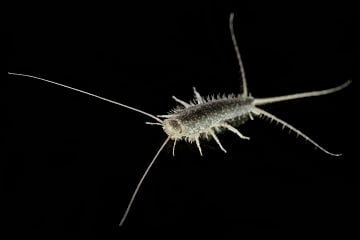
A wingless, grayish-silver beetle with long antennae known as a silverfish critters over the undersides of houses in moist areas.
The term “silverfish” is accurate in the description of this pest. The bug moves fast across the floor with fish-like fin-lie movements and a silvery look.
The length of the silverfish can range from 12-25 mm. Anywhere in wet attics, baths, and showers, silverfish can be a frequently happening infestation.
This can be easily identified because of the silver color and a tapering end. The two antennae and the tail make it easily recognizable as a fish-like monument.
How to get rid of Silverfish
- Borax is a quick way to put an end to the life of a silverfish.
- Use sticky traps to capture the silverfish.
- Carefully put out silverfish poisoning.
Bed bugs (Cimex)
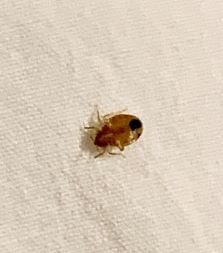
Bed bugs are tiny reddish-brown insects and can be as small as a seed of an apple. They have flattened bodies and can have a length of up to 4-5 mm. They even resemble the appearance of a tick, termites, or fleas.
Bed bug bites on humans can cause severe itching and rash on the neck, hands, feet, or face.
These mite infestations are the most difficult to get rid of, as they can go on for about 2 months without eating.
They can be identified easily on beds and mattresses as small bugs with flattened oval bodies and tiny heads.
How to get rid of bed bugs
- Vacuum your room with a HEPA filter.
- Dry your clothes on high heat in your dryer
- Deep clean your mattresses and wash all fabrics and linens.
Time To Throw The Little Buggers Out Of Your House
Tiny house bugs can not only be terrifying, but can cause ultimate damage to your furniture, and your health.
These bugs can be identified easily and can be taken out of the root for the betterment of your home. Remember to take all the necessary steps and extra precautions to keep your house away from all the mess of the pest.
Also, if you’re designing a tiny home – consider designing it with bug prevention techniques in-mind, so that you solve the problem before it becomes one.
Finally, keep your house, clothes, mattress, and carpets as deeply cleaned as possible. Thank you for reading! We hope this information was helpful.
FAQs – Tiny House Bugs
Why am I getting little bugs in my house?
Bugs have the same way of life as any other creature on this planet. Food sources, heat, and shelter. If all this is available in your house, they are likely to become unwanted guests. Cockroaches, carpet beetles, spiders, houseflies, and weevils are among some of the common bugs found inside houses.
How do I get rid of bugs in my tiny house?
Use an insecticide. It is the fastest way to get rid of bugs. However, to keep infestations as far as possible, get a pest control company a minimum of 4 times a year.
Also, keep your house clean, and your sinks and baths as dry as possible. Seal all possible crevices and openings on your windows and doors to keep them creepers away.
Does vinegar drive away bugs?
Vinegar, especially acetic acid, is a killer pest control tool. It can repel the most common nuisances and can even kill the weaker insects. It is all the more effective to use against spiders, mosquitoes, and ants.
What repels little bugs?
Peppermint, cedar, lavender oils, lemongrass, eucalyptus, and tea tree have the properties to act as a decent bug repellent. You can even combine two or more oils to make an anti-bug potion. Just mix water and oils at a 3:1 ratio, and you’re good to go.